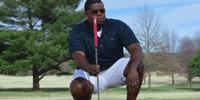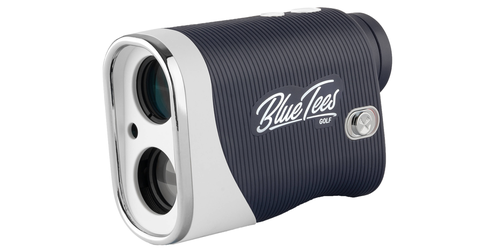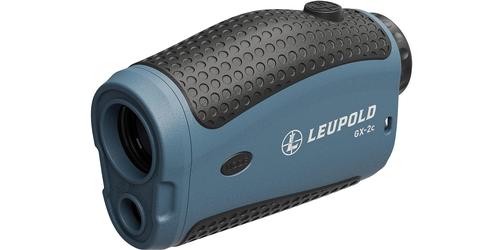Golf Review: Sonic Golf - Feedback for Golfers
By John Ehle
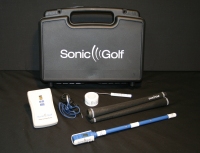
I can't help but picture Renee Russo, the gorgeous love interest in "Tin Cup" when I think about the many game improvement devices that I've seen across the more than 50 years that I've been playing golf. Her appearance at Kevin Costner's humble range for her first lesson may be the funniest portrayal ever of the absurd gear that has been foisted upon us over the years.
She is encumbered by more straps, belts, trusses, glasses and goofy gear than I thought possible and Costner's efforts to improve her swing only begins after she has been divested of her game improvement toys. Some of them looked strangely familiar.
Most of us have had the opportunity to be tested on a launch monitor; learning all about launch angle, clubhead speed, MOI, angle of descent, carry, ball speed, smash factor, trajectory...... ad infinitum. But who among us can afford one of these sophisticated machines? Not I. And, truth be told, the common motivation for using the computerized monitor is to convince the golfer that he/she needs a new 460cc driver worth anywhere from $400 to $600 dollars. Or, possibly, a whole set of irons.
Now, video is great. Being able to see one's golf swing can be instructive in terms of what is happening mechanically....even to the point of comparing one's swing with an overlay of the greatest golf swings in the world. But what do we really take from the experience which moves us in the direction of an improved pass at the ball? Not much, really. We are creatures of feel and feedback from the handle of the golf club and, to a certain extent, the visual of the ball flight. What sense might provide us with something palpable, measurable and enlightening as feedback from a golf swing? Sound.
Dr. Robert Grober is a professor of experimental physics at Yale University and he is also an avid golfer; so avid that he teaches a physics class at Yale which uses golf as a vehicle to teach the principles of physics. This is not the proverbial "gut" class that that attracts the student in search of an easy 3 credit course. The minimum prerequisites include AP or introductory college physics and calculus. The class usually starts out quite large as the title (The Physics of the Game of Golf) is definitely alluring. But, after the second class, the merely golf-addled move on in search of weaker academic prey. Those who remain, according to Professor Grober, are mostly engineers who are also golfers.
Bob Grober's search began years ago and like most research his work did not culminate in an "aha" moment. He has been working with the data created by the golf swing since 1992. "Basically, doing experimental physics involves gathering data and eventually, my work focused on gathering data involving the movement of the golf club. My work with this is basically a passion which got out of control", Grober said.
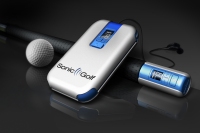
Using technology which emerged in the creation of the airbag, Dr. Grober found that sound was a superior modality than video or the dots and waves on a spectroscope. Once he settled on sound as the most palpable mode of communicating the tempo and rhythm of the golf swing it was just a matter of developing the technology that would produce feedback which would make learning accessible immediately. Again, sound was the answer.
As I spoke with him from his office on the Yale campus in New Haven, CT, his passion for the project was readily apparent. "The merging of electronics and golf was inevitable and what we've been able to accomplish in the past five years is to settle on the reproduction of data in "real time". So rather than using data which is reproduced on a screen or on paper, we've shifted the paradigm and the result is different than anything else that is available.To allow the golfer to do his/her own analysis according to what they hear is new".
My own experiment with the Sonic Golf system began on a sunny spring day at my clubmaker's shop. The installation of the transmitter requires the removal of the grip from your driver and the re-gripping with the custom Golf Pride grip with a removeable cap. The transmitter is then inserted into the handle of the shaft. This procedure took only minutes and I was off to the range. The other components are technically sophisticated but simple to use. The transmitter is wireless so it sends the motion data to the receiver which can be clipped to or slid into a back pocket. Then the plug for the earphones is inserted into the receiver(digital audio synthesizer) and a channel is selected both on the synthesizer and the transmitter. As soon as I put the earphones on I could hear musical tones which sounded like organ music. After warming up with a wedge, I began hitting balls with my newly appointed driver and the sound was remarkable.
I had recently been working on my tempo so as I slowed down my swing the variance in the sound was remarkable. A good, rhythmic swing produced a flourish that E. Power Biggs would have been proud of. A quick swing with little or no pause at the top produced something less pleasing. I hit 50-60 golf balls that morning and found that I controlled my own sound production according to how effectively I was able to make a swing with good tempo. The beauty of the system exceeds the efficiency of being able to use one's own club. It is simple to install and just as simple to use. The production of the swing music is entirely up to the golfer.
This is a whole new modality which is very easy to relate to. Not only is the harmonious production of sound a teaching tool, yu are hitting golf balls and can draw the obvious conclusions (or correlations) between sight and sound. If the flight of the ball occurs in concert with pleasing sounds, the golfer has access to learning which makes irrelevant the position concerns which golf instruction has been focusing on for years.
Epiphany is the word that comes to mind but suffice it to say that the initial learning curve was steep; followed by the opportunity to adjust one's swing slightly to produce more gratifying results.
Dr. Grober is now working through the nuances of marketing in order to put his invention in the hands of golfers. You can learn more about Sonic Golf at www.sonicgolf.com or at info@sonicgolf.com or by calling 203-764-2046.
Article Tags: Sonic Golf
Revised: 05/17/2009 - Article Viewed 32,108 Times
About: John Ehle
![]() John Ehle writes for GolfWisconsin.com, GolfTrips,com and other golf-related sites in the US. He has attended 6 Open Championships in the British Isles and many men's and women's US Opens and PGA Championships as well as Ryder Cups and President's Cups.
John Ehle writes for GolfWisconsin.com, GolfTrips,com and other golf-related sites in the US. He has attended 6 Open Championships in the British Isles and many men's and women's US Opens and PGA Championships as well as Ryder Cups and President's Cups.
His primary international writing is golf course reviews and travel articles. He also writes about golf equipment and other golf-related products. Most recently he traveled to Cuba and will be in SE Asia for 6 weeks in February and March, 2012.
He writes a weekly column for a metropolitan newspaper in the Milwaukee, Wisconsin area. He is a 10 handicap golfer and has competed in many Wisconsin State Golf Association events.




